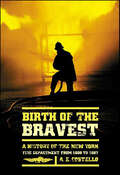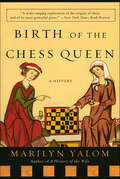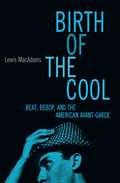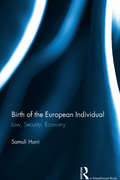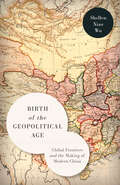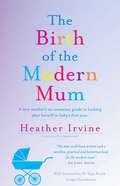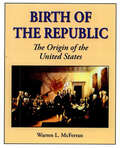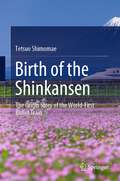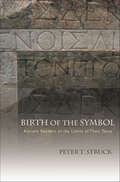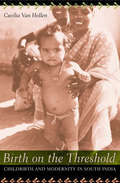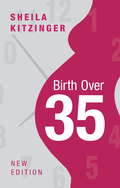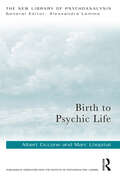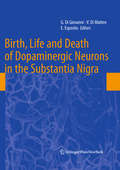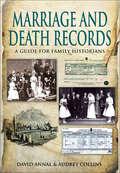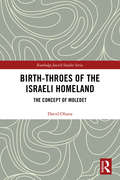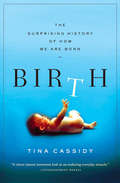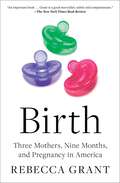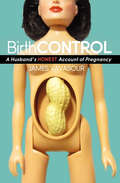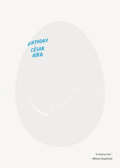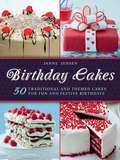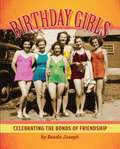- Table View
- List View
Birth of the Bravest: A History of the New York Fire Department from 1609 to 1887
by A. E. CostelloBirth of the Bravest is a substantially abridged edition of Our Firemen: A History of the New York Fire Departments, Volunteer and Paid by A. E. Costello, which was originally published in 1887. This edition includes all of the revealing historic events and exploits while deleting over 400 pages of lists, inventories, and personnel records.They are called "the Bravest." They are the New York City Fire Department, ordinary men who put themselves on the line every day to save lives, and this is a chronicle of their early history.Birth of the Bravest traces the history of New York firefighting from the earliest days of the city, when it was part of the Dutch settlement of New Amsterdam, to the end of the nineteenth century, when new innovations in firefighting technology began to make their appearance. Along the way are many tales of heroism and bravery, including accounts of the disastrous fire of 1811, the great conflagration of 1835, the awful fire of 1845, and many other signature events in New York City's history.Birth of the Bravest also documents the history of firefighting itself, the birth and evolution of fire companies (both "volunteer and paid"), legislated fire regulations, the development of new equipment to aid the bravest in their mission, and the birth of fire insurance. It also tracks individual exploits of great heroism, on the job and off, as many members went off to serve in the Civil War.A seminal part of New York City history, this chronicle of the evolution of the Fire Department is an informative tribute to the men who are New York City's Bravest.At the Publisher's request, this title is being sold without Digital Rights Management Software (DRM) applied.
Birth of the Chess Queen: A History
by Marilyn Yalom“Marilyn Yalom has written the rare book that illuminates something that always has been dimly perceived but never articulated, in this case that that the power of the chess queen reflects the evolution of female power in the western world.” —Cleveland Plain DealerEveryone knows that the queen is the most dominant piece in chess, but few people know that the game existed for five hundred years without her. It wasn't until chess became a popular pastime for European royals during the Middle Ages that the queen was born and was gradually empowered to become the king's fierce warrior and protector.Birth of the Chess Queen examines the five centuries between the chess queen's timid emergence in the early days of the Holy Roman Empire to her elevation during the reign of Isabel of Castile. Marilyn Yalom, inspired by a handful of surviving medieval chess queens, traces their origin and spread from Spain, Italy, and Germany to France, England, Scandinavia, and Russia. In a lively and engaging historical investigation, Yalom draws parallels between the rise of the chess queen and the ascent of female sovereigns in Europe, presenting a layered, fascinating history of medieval courts and internal struggles for power.
Birth of the Cool
by Lewis MacadamsMiles Davis and Juliette Greco, Jackson Pollock and Jack Kerouac, Marlon Brando and Bob Dylan and William Burroughs. What do all these people have in common? Fame, of course, and undeniable talent. But most of all, they were cool. Birth of the Cool is a stunningly illustrated, brilliantly written cultural history of the American avant-garde in the 1940s and 1950s -- the decades in which cool was born. From intimate interviews with cool icons like poet Allen Ginsberg, bop saxophonist Jackie McLean, and Living Theatre cofounder Judith Malina, award-winning journalist and poet Lewis MacAdams extracts the essence of cool. Taking us inside the most influential and experimental art movements of the twentieth century -- from the Harlem jazz joints where Dizzy Gillespie and Charlie Parker invented bebop to the back room at Max's Kansas City when Andy Warhol was holding court to backstage at the Newport Folk Festival the night Bob Dylan went electric, from Surrealism to the Black Mountain School to Zen -- MacAdams traces the evolution of cool from the very fringes of society to the mainstream. Born of World War II, raised on atomic-age paranoia, cast out of the culture by the realities of racism and the insanity of the Cold War, cool is now, perversely, as conventional as you can get. Allen Ginsberg suited up for Gap ads. Volvo appropriated a phrase from Jack Kerouac's On the Road for its TV commercials. How one became the other is a terrific story, and it is presented here in a gorgeous package, rich with the coolest photographs of the black-and-white era from Robert Doisneau, Henri Cartier-Bresson, Man Ray, and many others. Drawing a direct line between Lester Young wearing his pork-pie hat and his crepe-sole shoes staring out his hotel window at Birdland to the author's three-year-old daughter saying "cool" while watching a Scooby-Doo cartoon at the cusp of a new millennium, Birth of the Cool is a cool book about a hot subject...maybe even the coolest book ever.
Birth of the European Individual: Law, Security, Economy
by Samuli HurriThis book examines the birth of the European individual as a juridical problem, focusing on legal case dossiers from the European Court of Justice as an electrifying laboratory for the study of law and society. Foucault’s story of the modern subject constitutes the book’s main theoretical inspiration, as it considers the encounter between legal and other practices within a more general field of juridical power: a network of active relations, between different social spheres. Through the analysis of delinquent individuals – each expelled from one of the Member States – the raw material for constructing the idea of the European individual is uncovered. The European individual, it is argued, emerged out of the intersection of regimes of law, security and economy, and its practices of knowledge-power. Birth of the European Individual: Law, Security, Economy will be of interest to those studying the individual in law, as well as anyone considering the relationships between power and the individual.
Birth of the Geopolitical Age: Global Frontiers and the Making of Modern China
by Shellen Xiao WuFrom the 1850s until the mid-twentieth century, a period marked by global conflicts and anxiety about dwindling resources and closing opportunities after decades of expansion, the frontier became a mirror for historically and geographically specific hopes and fears. From Asia to Europe and the Americas, countries around the world engaged with new interpretations of empire and the deployment of science and technology to aid frontier development in extreme environments. Through a century of political turmoil and war, China nevertheless is the only nation to successfully navigate the twentieth century with its imperial territorial expanse largely intact. In Birth of the Geopolitical Age, Shellen Xiao Wu demonstrates how global examples of frontier settlements refracted through China's unique history and informed the making of the modern Chinese state. Wu weaves a narrative that moves through time and space, the lives of individuals, and empires' rise and fall and rebirth, to show how the subsequent reshaping of Chinese geopolitical ambitions in the twentieth century, and the global transformation of frontiers into colonial laboratories, continues to reorder global power dynamics in East Asia and the wider world to this day.
Birth of the Leviathan
by Thomas ErtmanFor many years scholars have sought to explain why the European states which emerged in the period before the French Revolution developed along such different lines. Why did some become absolutist and others constitutionalist? What enabled some to develop bureaucratic administrative systems, while others remained dependent upon patrimonial practices? This book presents a new theory of state-building in medieval and early modern Europe. Ertman argues that two factors - the organisation of local government at the time of state formation and the timing of sustained geo-military competition - can explain most of the variation in political regimes and in state infrastructures found across the continent during the second half of the eighteenth century. Drawing on insights developed in historical sociology, comparative politics, and economic history, this book makes a compelling case for the value of interdisciplinary approaches to the study of political development.
Birth of the Modern Mum
by Heather IrvineSo much of modern motherhood is targeted at looking good even when you feel crap and making your baby look good even though he or she won't settle or feed or stop crying, all in the shortest time frame possible. The Miranda Kerr and Heidi Klums of the world make it look easy; have a baby and get back on the runway 2 minutes later with a flat stomach, silky hair and glowing skin. What about the mothers who get acne from pregnancy, or whose hair turns grey, or can't loose their baby belly in 10 seconds flat? This book is for them. Heather Irvine, Clinical Psychologist and head of the R.E.A.D Clinic, appropriately balances clinical expertise with common sense "mother appeal" for mothers struggling in their baby's first year. The Birth of the Modern Mum looks at the serious issues such as Postnatal Depression (PND), relationship changes and physical changes that mothers face in their first year with a new baby while still providing light-hearted quick fixes that any mother can implement in short period of time. Heather taps into the realistic image of motherhood leaving behind the doldrums of medical professionally written books. The Birth of the Modern Mum is a book that any mother can be proud of. It can be placed on the coffee table right next to the Women's Day or Famous magazines without shame should guests drop by. Because whilst the book tackles the factors that underlie PND and related cognitive and affective dysfunction no mother wants to have a heavy PND-title book sitting around in her lounge room. And let's face it, once a book is put away on the bookshelf, in the life of a busy mum it's unlikely to come out again.
Birth of the Republic: The Origin of the United States
by Warren L. McFerranA chronicle of the rise of American civilization from its inception through the American Revolution and the Constitutional Convention of 1787, this scholarly text examines the differences between a national, or centralized and consolidated, system and a federal, or localized and state-focused, system of government. Emphasizing the Christian foundations of the United States, the colonial preference for principles of federalism, and the American rejection of socialism, Warren L. McFerran provides a detailed analysis of the Declaration of Independence, the Articles of Confederation, the Federalist Papers, and the federal Constitution.During the Constitutional Convention of 1787, the delegates introduced contending plans of government and an intense struggle between the advocates of federalism and nationalism emerged. The champions of federalism and state sovereignty triumphed at that convention, yet this essential policy of power decentralization was to change in the centuries to follow. With conviction, McFerran brings this discourse of federalism vs. nationalism into the twenty-first century, exposing the present big, national government as one hostile to the liberties of the American people. He ultimately demonstrates the manners in which a federal system best serves the freedoms of Americans, much as our Founding Fathers intended.
Birth of the Shinkansen: The Origin Story of the World-First Bullet Train
by Tetsuo ShimomaeThis book discusses the Shinkansen, the world's first high-speed railway, which was born in Japan in 1964 and how it has developed up to the present day. In the 1950s, some European railways were trying to increase the commercial operating speed up to 160 km/h, and it was considered difficult to raise it to 200 km/h. Japanese engineers with excellent engineering ability post World War ll moved from the military to the railways to overcome the technological challenges realizing the high-speed railways using new approaches. The book discusses the technological barriers in speeding up the railway at that time and how these engineers overcame them in non-computer days. In the five decades since the Shinkansen began operating, there have been significant developments enabling high-speed, safe, and frequent train operation with high punctuality while conserving the environment. The book also describes today’s highly evolved Shinkansen. The Shinkansen, which runs 440,000 km a day, has carried 13.3 billion people without a single fatality in 56 years. The book overviews factors that contributed to the Shinkansen’s high safety record. This book is an excellent guide for those interested in the history of the world’s first high-speed railway.
Birth of the Swatch
by Youngme MoonIn 1993, the Swatch is the best-selling watch in history. Traces the history of the watch industry up to the early 1980s, when the Swatch was introduced. Describes the various elements that made the Swatch different from any watch the industry had ever seen. Also includes a discussion of SMH, which controls Swatch, exploring how the company has managed the Swatch brand in the context of its brand portfolio (nine global watch brands in total.)
Birth of the Symbol: Ancient Readers at the Limits of Their Texts
by Peter T. StruckNearly all of us have studied poetry and been taught to look for the symbolic as well as literal meaning of the text. Is this the way the ancients saw poetry? In Birth of the Symbol, Peter Struck explores the ancient Greek literary critics and theorists who invented the idea of the poetic "symbol." The book notes that Aristotle and his followers did not discuss the use of poetic symbolism. Rather, a different group of Greek thinkers--the allegorists--were the first to develop the notion. Struck extensively revisits the work of the great allegorists, which has been underappreciated. He links their interest in symbolism to the importance of divination and magic in ancient times, and he demonstrates how important symbolism became when they thought about religion and philosophy. "They see the whole of great poetic language as deeply figurative," he writes, "with the potential always, even in the most mundane details, to be freighted with hidden messages."Birth of the Symbol offers a new understanding of the role of poetry in the life of ideas in ancient Greece. Moreover, it demonstrates a connection between the way we understand poetry and the way it was understood by important thinkers in ancient times.
Birth on the Threshold
by Cecilia Van HollenEven childbirth is affected by globalization--and in India, as elsewhere, the trend is away from home births, assisted by midwives, toward hospital births with increasing reliance on new technologies. And yet, as this work of critical feminist ethnography clearly demonstrates, the global spread of biomedical models of childbirth has not brought forth one monolithic form of "modern birth." Focusing on the birth experiences of lower-class women in the South Indian state of Tamil Nadu, Birth on the Threshold reveals the complex and unique ways in which modernity emerges in local contexts. Through vivid description and animated dialogue, this book conveys the birth stories of the women of Tamil Nadu in their own voices, emphasizing their critiques of and aspirations for modern births today. In light of these stories, author Cecilia Van Hollen explores larger questions about how the structures of colonialism and postcolonial international and national development have helped to shape the form and meaning of birth for Indian women today. Ultimately, her book poses the question: How is gender--especially maternity--reconfigured as birth is transformed?
Birth on the Threshold: Childbirth and Modernity in South India
by Cecilia Van HollenThrough vivid description and animated dialogue, this book conveys the birth stories of the women of Tamil Nadu in their own voices, emphasizing their critiques of and aspirations for modern births today.
Birth over 35
by Sheila KitzingerBirth statistics from the Office for National Statistics show that more women than ever before become mothers later in life. The trend is also backed up by figures from other countries around the world. In developed countries there is an upsurge in the age of mothers giving birth for the first time, and in the UK alone there are now more first-time mothers giving birth in the 30-34 age group than in the 25-29 age group. There is also a 50% increase from 10 years ago in the number of women aged 40 - 44 who are having a baby. Women over 35 (or even younger) expecting a first baby are automatically assigned to a "high risk" category, at risk for problems such as hypertension, pre-eclampsia, diabetes, difficult labour, and caesarean section. Research, however, suggests that the mother's overall health is more important than age per se. This updated version of Birth Over 35 (Sheldon Press 1994, Birth Over 30, Sheldon Press 1982) provides the specialist information needed by 'older' mothers.
Birth over 35 (Overcoming Common Problems Ser.)
by Sheila KitzingerBirth statistics from the Office for National Statistics show that more women than ever before become mothers later in life. The trend is also backed up by figures from other countries around the world. In developed countries there is an upsurge in the age of mothers giving birth for the first time, and in the UK alone there are now more first-time mothers giving birth in the 30-34 age group than in the 25-29 age group. There is also a 50% increase from 10 years ago in the number of women aged 40 - 44 who are having a baby. Women over 35 (or even younger) expecting a first baby are automatically assigned to a "high risk" category, at risk for problems such as hypertension, pre-eclampsia, diabetes, difficult labour, and caesarean section. Research, however, suggests that the mother's overall health is more important than age per se. This updated version of Birth Over 35 (Sheldon Press 1994, Birth Over 30, Sheldon Press 1982) provides the specialist information needed by 'older' mothers.
Birth to Psychic Life (New Library of Psychoanalysis)
by Albert Ciccone Marc LhopitalBased on rich clinical experience and on theory from numerous psychoanalytical works, this book explores and analyzes the emergence and development of the psychic life. Birth to Psychic Life explores the genesis of the psychic apparatus, reconstructs the development of subjectivity, with its ups and downs in babies as in all subjects, and studies the relationship between mental states at the dawn of psychic life and those characteristic of psychopathology. The book refers to Freudian, Kleinian and post-Kleinian works, proposing articulations between the different theoretical models. The referenced works’ contributions to the understanding of early psychic disorders, as well as to the implications of infantile psychic suffering in adulthood, are essential. The authors identify the three psychic constellations, recognized by many, that accompany the psychic birth and suggest new more adequate names in view of current works on subjectivity: the auto-sensual position, the symbiotic position and the depressive position. Many other new and original proposals are developed by the authors. Providing tools to think about the processes of psychic growth, this book will be of interest to all psychoanalysts and psychotherapists working with infants and interested in the impact of early psychic development throughout life.
Birth, Life and Death of Dopaminergic Neurons in the Substantia Nigra (Journal of Neural Transmission. Supplementa #73)
by Vincenzo Di Matteo Giuseppe Di Giovanni Ennio EspositoThis book provides a unique and timely multidisciplinary synthesis of our current knowledge of the anatomy, pharmacology, physiology and pathology of the substantia nigra pars compacta (SNc) dopaminergic neurons. The single chapters, written by top scientists in their fields, explore the life cycle of dopaminergic neurons from their birth to death, the cause of Parkinson's disease, the second most common and disabling condition in the elderly population. Nevertheless, the intracellular cascade of events leading to dopamine cell death is still unknown and, consequently, treatment is symptomatic rather than preventive. The mechanisms by which alterations cause neuronal death, new therapeutic approaches and the latest evidence of a possible de novo neurogenesis in the SNc are reviewed and singled out in different chapters. This book bridges basic science and clinical practice and will prepare the reader for the next few years, which will surely be eventful in terms of the progress of dopamine research.
Birth, Marriage and Death Records: A Guide for Family Historians
by David AnnalBirth, marriage and death records are an essential resource for family historians, and this handbook is an authoritative introduction to them. It explains the original motives for registering these milestones in individual lives, describes how these record-keeping systems evolved, and shows how they can be explored and interpreted. Authors David Annal and Audrey Collins guide researchers through the difficulties they may encounter in understanding the documentation. They recount the history of parish registers from their origin in Tudor times, they look at how civil registration was organized in the nineteenth and twentieth centuries and explain how the system in England and Wales differs from those in Scotland and Ireland. The record-keeping practiced by nonconformist and foreign churches, in communities overseas and in the military is also explained, as are the systems of the Isle of Man and the Channel Islands. Other useful sources of evidence for births, marriages and deaths are explored and, of course, the authors assess the online sites that researchers can turn to for help in this crucial area of family history research.
Birth-Throes of the Israeli Homeland: The Concept of Moledet (Routledge Jewish Studies Series)
by David OhanaThe book brings forth various perspectives on the Israeli "homeland" (moledet) from various known Israeli intellectuals such as Boaz Evron, Menachem Brinker, Jacqueline Kahanoff and more. Binding together various academic fields to deal with the question of the essence of the Israeli homeland: from the examination of the status of the Israeli homeland by such known sociologist as Michael Feige, to the historical analysis of Robert Wistrich of the place Israel occupies in history in relation to historical antisemitism. The study also examines various movements that bear significant importance on the development of the notion of the Israeli homeland in Israeli society: Such movement as "The New Hebrews" and Hebrewism are examined both historically in relation to their place in Zionist history and ideologically in comparison with other prominent movements. Drawing on the work of Jacqueline Kahanoff to provide a unique Mediterranean model for the Israeli homeland, the volume examines prominent models among the Religious Zionist sector of Israeli society regarding the relation of the biblical homeland to the actual homeland of our times. Discussing the various interpretations of the concept of the nation and its land in the discourse of Hebrew and Israeli identity, the book is a key resource for scholars interested in nationalism, philosophy, modern Jewish history and Israeli Studies.
Birth: The Surprising History of How We Are Born
by Tina Cassidy"Well-researched and engaging . . . Birth is a clever, almost irreverent look at an enduring everyday miracle. (A-)” -Entertainment Weekly"Wonderful. Packed full of information, a brilliant mixture of ancient wisdom and modern science.” -Kate Mosse, author of the New York Times best seller, Labyrinth"Birth is a power-packed book. . . . A lively, engaging, and often witty read, a quirky, eye-opening account of one of life’s most elemental experiences.” -The Boston GlobePublished to widespread acclaim, Tina Cassidy’s smart, engaging book is the first world history of childbirth in fifty years. From evolution to the epidural and beyond, Tina Cassidy presents an intelligent, enlightening, and impeccably researched cultural history of how and why we’re born the way we are. Women have been giving birth for millennia but that’s about the only constant in the final stage of the great process that is human reproduction. Why is it that every culture and generation seems to have its own ideas about the best way to give birth? Cassidy explores the physical, anthropological, political, and religious factors that have and will continue to influence how women bring new life into the world.
Birth: Three Mothers, Nine Months, and Pregnancy in America
by Rebecca Grant&“An important book...Grant is a good storyteller, subtle and compassionate.&” —The New York Times Book Review In the tradition of Random Family and Evicted, a gripping blend of rigorous, intimate on-the-ground reporting and deep social history of reproductive health that follows three first-time mothers as they experience pregnancy and childbirth in today&’s America.Journalist Rebecca Grant provides us with a never-before-seen look at the changing landscape of pregnancy and childbirth in America—and the rise of midwifery—told through the eyes of three women who all pass through the doors of the same birth center in Portland, Oregon. There&’s Alison, a teacher whose long path to a healthy pregnancy has led her to question a traditional hospital birth; T&’Nika, herself born with the help of a midwife and now a nurse hoping to work in Labor & Delivery and improve equality in healthcare; and Jillian, an office manager and aspiring midwife who works at Andaluz Birth Center, excited for a new beginning, but anxious about how bringing a new life into the world might mean the deferral of her own dreams. In remarkable detail and with great compassion, Grant recounts the ups downs, fears, joys, and everyday moments of each woman&’s pregnancy and postpartum journey, offering a rare look into their inner lives, perspectives, and choices in real time—and addresses larger issues facing the entire nation, from discrimination in medicine and treatment (both gender and race-based) to fertility, family planning, complicated feelings about motherhood and career, and the stigmas of miscarriage and postpartum blues. &“An enlightening and accessible portrait of maternal healthcare in America" (Publishers Weekly, starred) Birth is an inspiring look at one of life&’s most profound rites of passage.
BirthCONTROL: A Husband's Honest Account of Pregnancy
by James VavasourIn this heartfelt and hilarious memoir, a father recounts his many trials and occasional triumphs during he and his wife&’s first pregnancy, week by week. More than four million blissfully ignorant American men are thrust into fatherhood every year, yet these men rarely know what to expect in those crucial first nine months. In BirthCONTROL, author and father James Vavasour offers a real-time, week-by-week account of his journey from pursuing the perfect pregnancy to learning to let go of control. James documented his experiences as they happened in order to capture them in all their wonder, neuroses, and panic. This rare, honest, and unmoderated male perspective on pregnancy will be educational for any couple thinking of starting a family. For those already pregnant, it is a funny, relatable, and often neurotic vision of the day-to-day struggles encountered during this profoundly hormonal time in a couple&’s life. If you&’ve ever had to settle on a baby&’s name or the color of a nursery, be publicly humiliated during birthing classes, or run the obstacle course otherwise known as a grocery store with someone days away from delivery, you&’ll understand.
Birthday
by César AiraBirthday is among the very best of Aira—it will surprise readers new to his work, and will deeply satisfy his many fans Before you know it you are no longer young, and by the way, while you were thinking about other things, the world was changing—and then, just as suddenly you realize that you are fifty years old. Aira had anticipated his fiftieth—a time when he would not so much recall years past as look forward to what lies ahead—but the birthday came and went without much ado. It was only months later, while having a somewhat banal conversation with his wife about the phases of the moon, that he realized how little he really knows about his life. In Birthday Aira searches for the events that were significant to him during his first fifty years. Between anecdotes ,and memories, the author ponders the origins of his personal truths, and meditates on literature meant as much for the writer as for the reader, on ignorance, knowledge, and death. Finally, Birthday is a little sad, in a serene, crystal-clear kind of way, which makes it even more irresistible.
Birthday Cakes: 50 Traditional and Themed Cakes for Fun and Festive Birthdays
by Janne Jansen50 Recipes for birthday cakes.
Birthday Girls Celebrating The Bonds of Friendship
by Reeda JosephCelebrating life's special moments are what birthdays are all about- and these occasions are made all the more special with time spend with your bff's. Reeda Josephs, the creator and CWO (Chief Wit Officer) of the Wright Card Company has gathered adorable, sweet, sassy and oh-so-funny gal pals and gaggles having a giggle and celebrating the bonds of friendship. From fab 50's to the swinging 60's, these vintage vixens jump of the page and into your heart. Reeda has an eye for rare images and these Birthday Girls are her finest collection ever paired with great good humor that is best shared with your friends. As Reeda herself says, 'Friendship is not a big thing, it is a million little things. ' Birthday Girls celebrates the bonds of true friendship with laughter and a lot of love!
